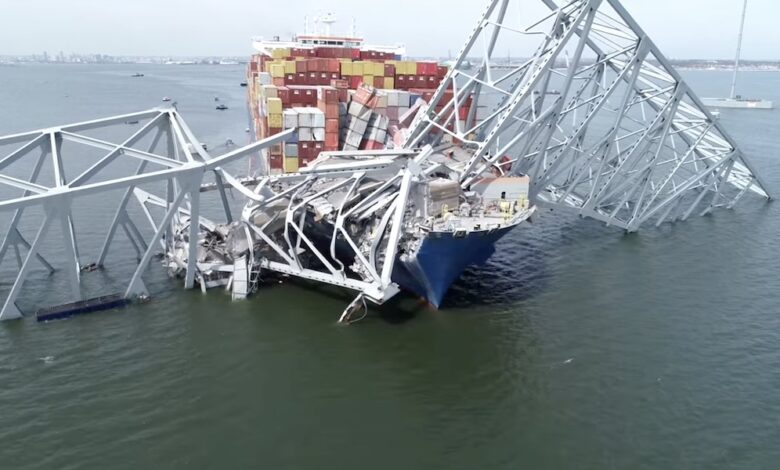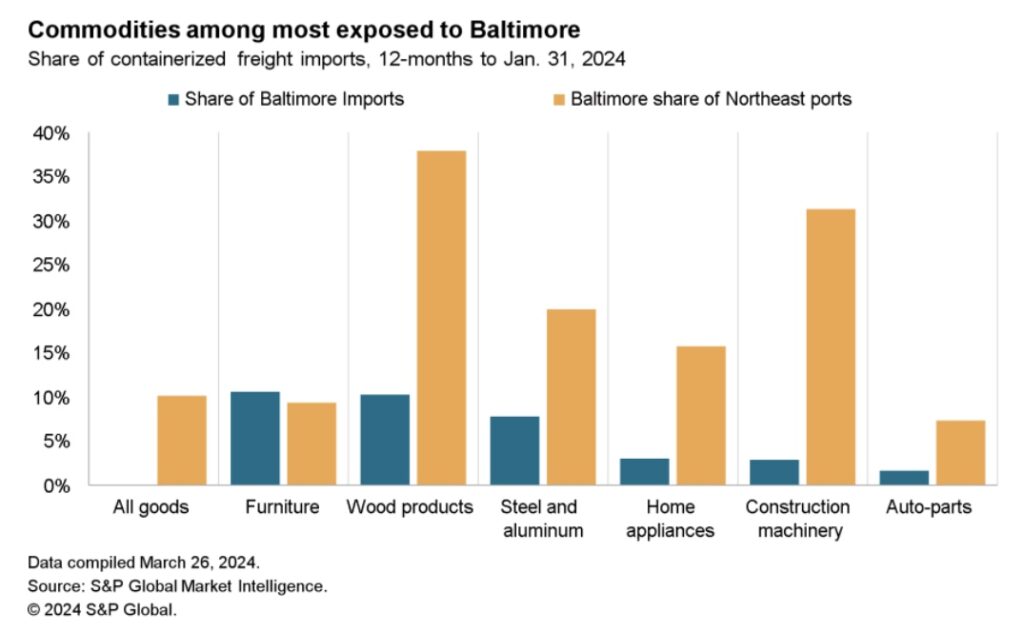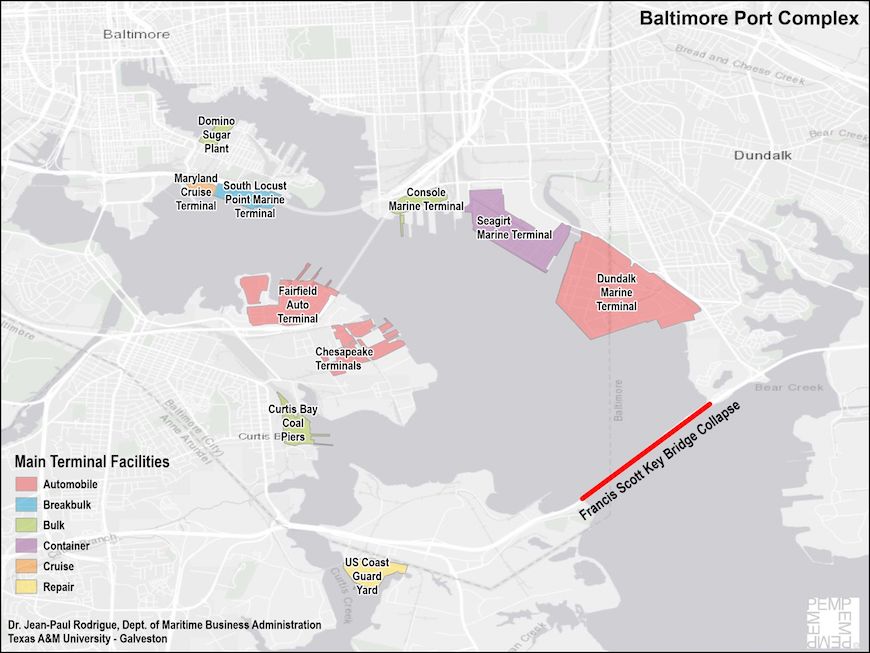Dali crew hailed as ‘heroes’ as details emerge of deadly Baltimore bridge smash

The president of the United States yesterday hailed the rapid actions of those onboard the ill-fated Dali containership in the moments before it slammed into a bridge in Baltimore, saying they had saved many lives.
Six people carrying out road repair on the Francis Scott Key Bridge are presumed to have died when they fell into the icy cold Patapsco River below at 1.30 am yesterday as the 300 m long box ship lost power and slammed into one of the pillars.
The bridge, a major thoroughfare, immediately collapsed, but calls from the ship just prior to impact ensured there were not more cars and people at risk.
“There’s a ship approaching that has lost their steering,” an official with the Maryland Transportation Authority can be heard saying in radio traffic recorded just prior to impact.
“Personnel onboard the ship were able to alert the Maryland Department of Transportation that they had lost control of their vessel, as you all know and have reported. As a result, local authorities were able to close the bridge to traffic before the bridge was struck, which undoubtedly saved lives,” President Joe Biden said yesterday.
Maryland governor Wes Moore described the crew as “heroes” and said that their quick response had “saved lives” because authorities were able to stop the flow of vehicle traffic on to the bridge in the two minutes between the call and the collision.
The vessel suffered a complete blackout, according to Clay Diamond, the executive director of the American Pilots Association, who was briefed by the state harbour pilots’ group. Video footage of the incident corroborates this, with the ship clearly losing power.
An inspection of the Dali last year at a port in Chile reported that the vessel had a deficiency related to “propulsion and auxiliary machinery.” The inspection, conducted on June 27 at the port of San Antonio, specified that the deficiency concerned gauges and thermometers. The vessel was also involved in an allision at the port of Antwerp in 2016.
The 9,962 teu Dali is listed on VesselsValue as owned by Grace Ocean Investment and registered in Singapore. All crewmembers, including the two pilots, were uninjured in the incident while the ship’s bow is badly damaged.
The vessel had left Baltimore at 1 am on Monday morning and was heading for Colombo, Sri Lanka, according to the maritime data platform MarineTraffic.
The Dali is chartered by Maersk and managed by Synergy Group on the 2M service between Asia and the US East Coast.
Maersk said yesterday it is now omitting Baltimore on all its services for the foreseeable future, until it is deemed safe for passage through the area.
All other shipping lines have had to reroute as well as debris from the downed bridge blocks the entrance to most terminals at the port, the ninth largest maritime gateway in America and one of the country’s top roro destinations. The debris has also trapped many ships in port.

Many containers have been badly damaged at the bow of Dali with cargo insurers WK Webster noting yesterday: “There is likely to be significant cargo loss and damage as a result of this very serious incident, including to a number of containers which are reported to be hanging from the bridge. It also seems almost certain that the vessel will not be proceeding with the voyage in the near future resulting in serious delays to all cargo on board.”
“At this stage it’s not possible to know what the reopening timeline may look like,” stated a report from broker Arrow. “Given the importance to automobile imports, the container trade, cruise ships and coal exports, we suspect there will be a concerted effort to reopen the port as quickly as possible. The impact on the local economy will begin immediately, consequently, resuming operations will likely become a priority.”
A map of the inaccessible main terminal facilities and their footprint in the Baltimore port complex has been created by Dr Jean-Paul Rodrigue from Texas A&M University and is carried below.


What about the bridge? Has it passed the inspections? Why there are not fenders around pillars??
Not requesting tugs can bec costly.
Heroes who killed at least 6 peoples will soon become suspects and then accused.
Again port authorities have been penalized for failing to ensure bridge pedestals are properly protected by earth, or other material, berms. The port of Vancouver, B.C., took this step some decades ago. As for the ship, it appears to have lost not only auxiliary power to both the main engine pumps, her steering motors, and therefore the engine, but also, if the video of her before she hit the bridge, when her navigation lights went out, is to be believed, it appears she not only lost auxiliary and main engine propulsion, but also her emergency generator, and even battery power! In the last event the navigation lights should default to battery power. What condition were the batteries in? Why didn’t the emergency generator kick in as the last auxiliary generator failed? It seems there is a lot about the engine room of the “Dali” that needs looking into. Further, passage through such a vital passage to the world’s economy should be effected at a reduce speed, and escorted by tugs.
Number of tugs should probably be multiplied by 3 or 5 to have enough capacity to escort each big vessel. Huge vessels are always source of catastrophic disasters. That’s a root of the problem. Add here short and chaotic port stay, lack of proper technical supervision and repairs, chronic undermanning (optimization), lack of rest for crew and one who knows this trade from inside, may wonder why such accidents are relatively not so frequent.
Good summing up, but its all down to $$$$$ these days be it the poor codes/original specs for bridge or the Dali as regards maintenance, training and retention of staff.
Why did it sail without correcting the blackout situation whilst alongside. $$$$$. Is the owner (not the charterer) going to pay port fees, off hire fees, repair fees for a makers man to attend if it was beyond the competence of the ships staff (there are some things best not touched, other than by the manufacturers man). I very much doubt it. $$$$$
As a former Master Colin, you will know about the wordings of Charter Parties, no doubt a ship hasn’t a leg to stand on.
Most vessels have manual,hydraulic override steering system.No electricity required.With prompt reaction from the bridge the course could have been altered by at least a couple degr.Reaction time is paramount in these situations
Manual systems to turn the rudder in this day and age. When was you last on a ship.
A lot of ships don’t have wheels now. Just a joystick that is electrical.
They dont have the traditional quadrant.They might have buttons on a couple of pump controllers, all of which needs power.
Gone are the days of rigging block and tackle to the till arm as there isn’t one. They are a hydraulic motor on top of the rudder stock, which could be 2’6″ in diameter, so imagine the size of the rudder and the power required to turn that to hard a starboard. Generally rudders only operate +/- 5°, except when at slow speeds, slower than 9 knots. These ships have a total compliment of master officers and crew of 20 or less and they are not big brawny jolly jacks, but scrawny weaklings.
2018 😉😅
Mareng knows All
It doesn’t matter how many back up systems anything has, the point is, will they work when they are required? Are the ships staff aware of these systems and how and when to engage them. Are these systems tested say monthly so everybody knows what do in a situation.
Are these ‘back up’ systems maintained correctly, do they carry spares in case something fails during a routine monthly test. With minimum manning via crewing agencies rather than ships staff being employees of the ship owner with a vested interest, are they just machinery minders and navigators to get the ships from ‘A-B’ with little incentive, time, competence or spares to maintain the ship.
Why did the Western shipping companies disapear?
Because foreign companies undercut them, the shippers wanted cheaper frieght rates, everybody wanted a new and latest i-pad each year. None of this stuff is made in the Western World. These foreign companies can undercut because they don’t spend the money on maintenance, training of staff, none of the foremost Classification Societies whose rules tend to be higher. Cheaper insurance for the ships. Everything is cut to the bone until something like this happens and the ship owner disapears through shell companies. Mearsk the charterer only asked this company to carry his cargo, Mearsk has their own ships, some of the largest in the world operated by European Masters and Officers Classed to the highest standards but had more cargo than they could handle and chartered this ship, which could well have been full of empty containers to be swopped for full ones as we make very little in the West.
When I was at sea in the 70-80’s we would leave the UK down to our marks with a full load of general cargo made in Britain, discharge in our colonies, the US , South America and return to Britain with a full load of frozen meat, chilled fruit etc.
We even carried Kiwi cheese to Philadelphia and Galveston
and that was before Pizza became a staple of American Haute Cuisine. Each voyage paying. This would be the same with the likes of Lykes Lines, US President lines and others , but were are they all now.
This is all driven by greedy shareholders who have no interest what the company does as long as it makes obscene profits and they get a good payout at the expense of peoples lives.
the local pilot was the one who called the mayday alert, not the crew of dali..
I think the pilot would have been understood much more easily and he would know what to say plus he would have said it in a clear distinct voice , without any panic. The operators would have recognised his voice. He perhaps realised he was in charge then and do something quickly. Using the ship’s typhon would not have meant anything to anybody on the road bridge, only to other ships, they may not have even spoken English if a message came over the VHF to them.